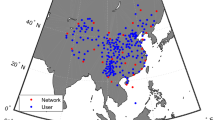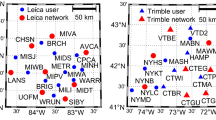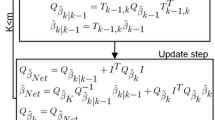Abstract
The concept of integer ambiguity resolution-enabled Precise Point Positioning (PPP-RTK) relies on appropriate network information for the parameters that are common between the single-receiver user that applies and the network that provides this information. Most of the current methods for PPP-RTK are based on forming the ionosphere-free combination using dual-frequency Global Navigation Satellite System (GNSS) observations. These methods are therefore restrictive in the light of the development of new multi-frequency GNSS constellations, as well as from the point of view that the PPP-RTK user requires ionospheric corrections to obtain integer ambiguity resolution results based on short observation time spans. The method for PPP-RTK that is presented in this article does not have above limitations as it is based on the undifferenced, uncombined GNSS observation equations, thereby keeping all parameters in the model. Working with the undifferenced observation equations implies that the models are rank-deficient; not all parameters are unbiasedly estimable, but only combinations of them. By application of \(\mathcal {S}\)-system theory the model is made of full rank by constraining a minimum set of parameters, or S-basis. The choice of this S-basis determines the estimability and the interpretation of the parameters that are transmitted to the PPP-RTK users. As this choice is not unique, one has to be very careful when comparing network solutions in different \(\mathcal {S}\)-systems; in that case the S-transformation, which is provided by the \(\mathcal {S}\)-system method, should be used to make the comparison. Knowing the estimability and interpretation of the parameters estimated by the network is shown to be crucial for a correct interpretation of the estimable PPP-RTK user parameters, among others the essential ambiguity parameters, which have the integer property which is clearly following from the interpretation of satellite phase biases from the network. The flexibility of the \(\mathcal {S}\)-system method is furthermore demonstrated by the fact that all models in this article are derived in multi-epoch mode, allowing to incorporate dynamic model constraints on all or subsets of parameters.



Similar content being viewed by others
References
Baarda W (1973) S-transformations and criterion matrices. In: Publications on geodesy, 18 (vol. 5, no. 1), Netherlands Geodetic Commission, Delft, The Netherlands
Banville S, Collins P, Zhang W, Langley RB (2014) Global and regional ionospheric corrections for faster PPP convergence. Navigation 61(2):115–124
Bar-Sever YE, Kroger PM, Borjesson JA (1998) Estimating horizontal gradients of tropospheric path delay with a single GPS receiver. J Geophys Res 103(B3):5019–5035
Boehm J, Schuh H (2004) Vienna mapping functions in VLBI analyses. Geophys Res Lett 31(1):L01603
Boehm J, Heinkelmann R, Schuh H (2007) Short note: a global model of pressure and temperature for geodetic applications. J Geodesy 81(10):679–683
Chatfield C (1994) The analysis of time series–an introduction, 4th edn. Chapman & Hall, London
Collins P, Bisnath S, Lahaye F, Heroux P (2010) Undifferenced GPS ambiguity resolution using the decoupled clock model and ambiguity datum fixing. Navigation 57(2):123–135
de Jonge PJ (1998) A processing strategy for the application of the GPS in networks. In: Publications on geodesy, 46, Netherlands Geodetic Commission, Delft, The Netherlands
Dow JM, Neilan RE, Rizos C (2009) The international GNSS service in a changing landscape of Global Navigation Satellite Systems. J Geodesy 83(3):191–198
Ge M, Gendt G, Rothacher M, Shi C, Liu J (2008) Resolution of GPS carier-phase ambiguities in precise point positioning (PPP) with daily observations. J Geodesy 82(7):389–399
Geng J, Bock Y (2013) Triple-frequency GPS precise point positioning with rapid ambiguity resolution. J Geodesy 87(5):449–460
Geng J, Teferle FN, Meng X, Dodson AH (2011) Towards PPP-RTK: ambiguity resolution in real-time precise point positioning. Adv Space Res 47(10):1664–1673
Goad CC (1985) Precise relative position determination using Global Positioning System carrier phase measurments in a nondifference mode. In: Proceedings of 1st international symposium on precise positioning with the Global Positioning System, Rockville, MD, 15–19 April, pp 347–356
Heroux P, Kouba J (1995) GPS precise point positioning with a difference. In: Paper presented at Geomatics ’95, Ottawa, Ontario, Canada, 13–15 June
Herring TA, Davis JL, Shapiro II (1990) Geodesy by radio interferometry: the application of Kalman filtering to the analysis of very long baseline interferometry data. J Geophys Res 95(B8):12561–12581
Hofmann-Wellenhof B, Lichtenegger H, Wasle E (2008) GNSS–Global Navigation Satellite Systems: GPS, GLONASS. Galileo & more, Springer, Wien, New York
Khodabandeh A, Teunissen PJG (2014) Array-based satellite phase bias sensing: theory and GPS/BeiDou/QZSS results. Meas Sci Technol 25
Komjathy A, Sparks L, Wilson BD, Mannucci AJ (2005) Automated daily processing of more than 1000 ground-based GPS receivers for studying intense ionospheric storms. Radio Sci 40:RS6006
Kouba J, Heroux P (2001) Precise point positioning using IGS orbit products. GPS Solut 5(2):12–28
Lannes A, Prieur J-L (2013) Calibration of the clock-phase biases of GNSS networks: the closure-ambiguity approach. J Geodesy 87(8):709–731
Lannes A, Teunissen PJG (2011) GNSS algebraic structures. J Geodesy 85(5):273–290
Laurichesse D, Mercier F, Berthias JP (2009) Zero-difference integer ambiguity fixing on single frequency receivers. In: Proceedings of ION ITM-2009, Anaheim, 26–28 Jan 2009, pp 2460–2469
Li X, Zhang X, Ge M (2011) Regional reference network augmented precise point positioning for instantaneous ambiguity resolution. J Geodesy 85(3):151–158
Li X, Ge M, Dousa J, Wickert J (2014) Real-time precise point positioning regional augmentation for large GPS reference networks. GPS Solut 18(1):61–71
Lindlohr W, Wells D (1985) GPS design using undifferenced carrier beat phase observations. Manuscr Geod 10:255–295
Montenbruck O, Hauschild A (2013) Code biases in multi-GNSS positioning. In: Proceedings of ION ITM-2013, San Diego, CA, 28–30 January, pp 616–628
Niell AE (1996) Global mapping functions for the atmosphere delay at radio wavelengths. J Geophys Res 101(B):3227–3246
Odijk D (2002) Fast precise GPS positioning in the presence of ionospheric delays. In: Publications on geodesy, 52, Netherlands Geodetic Commission, Delft, The Netherlands
Odijk D, Teunissen P, Zhang B (2012) Single-frequency integer ambiguity resolution enabled GPS precise point positioning. J Surv Eng 138:193–202. doi:10.1061/(ASCE)SU.1943-5428.0000085
Ovstedal O (2002) Absolute positioning with single-frequency GPS receivers. GPS Solut 5(4):33–44
Pratt J, Axelrad P, Larson KM, Lesage B, Gerrena R, DiOrio N (2013) Satellite clock bias estimation for iGPS. GPS Solut 17(3):381–389
Rao CR (1973) Linear statistical interference and its applications, 2nd edn. Wiley, New York
Rocken C, Ware R, Hove TV, Solheim F, Alber C, Johnson J (1993) Sensing atmospheric water vapor with the Global Positioning System. Geophys Res Lett 20(23):2631–2634
Saastamoinen J (1972) Atmospheric correction for the troposphere and stratosphere in radio ranging of satellites. In: Henriksen SW, Mancini A, Chovitz BH (eds) The use of artificial satellites in geodesy, vol 15. AGU Geophys Monogr, Washington, pp 247–251
Sardon E, Rius A, Zarraoa A (1994) Estimation of transmitter and receiver differential biases and the ionospheric total electron content from Global Positioning System observations. Radio Sci 29(3):577–586
Schaer S (1999) Mapping and predicting the Earth’s ionosphere using the Global Positioning System. PhD thesis, Astronomical Institute, University of Berne, Switzerland
Schönemann E, Becker M, Springer T (2011) A new approach for GNSS analysis in a multi-GNSS and multi-signal environment. J Geodetic Sci 1(3):204–214
Steigenberger P, Hugentobler U, Loyer S, Perosanz F, Prange L, Dach R, Uhlemann M, Gendt G, Montenbruck O (2015) Galileo orbit and clock quality of the IGS Multi-GNSS Experiment. Adv Space Res 55(1):269–281
Teunissen PJG (1985) Generalized inverses, adjustment, the datum problem and S-transformations. In: Sanso F, Grafarend EW (eds) Optimization of geodetic networks. Springer-Verlag, Berlin, Heidelberg, New York, Tokyo, pp 11–55
Teunissen PJG (1995) The least-squares ambiguity decorrelation adjustment: a method for fast GPS integer ambiguity estimation. J Geodesy 70:65–82
Teunissen PJG, Khodabandeh A (2013) BLUE, BLUP and the Kalman filter: some new results. J Geodesy 87(5):461–473
Teunissen PJG, Khodabandeh A (2015) Review and principles of PPP-RTK methods. J Geodesy 89(3):217–240
Teunissen PJG, Kleusberg A (1998) GPS for geodesy. Springer-Verlag, Berlin Heidelberg New York
Teunissen PJG, Odijk D, Zhang B (2010) PPP-RTK: results of CORS network-based PPP with integer ambiguity resolution. J Aeronaut Astronaut Aviat Ser A 42(4):223–230
Wen Z, Henkel P, Guenther C (2011) Reliable estimation of phase biases of GPS satellites with a local reference network. In: Proceedings of 53rd international symposium on ELMAR-2011, Zadar, Croatia, 14–16 September, pp 321–324
Wilson BD, Mannucci AJ (1993) Instrumental biases in ionospheric measurements derived from GPS data. In: Proceedings of ION-GPS 1993, Salt Lake City, UT, 22–24 September, pp 1343–1351
Wübbena G, Schmitz M, Bagge A (2005) PPP-RTK: precise point positioning using state-space reprentation in RTK networks. In: Proceedings of ION GNSS-2005, Long Beach, CA, 13–16 September, pp 2584–2594
Yunck TP (1993) Coping with the atmosphere and ionosphere in precise satellite and ground positioning. In: Jones AV (ed) Environmental effects on spacecraft trajectories and positioning, vol 73. AGU Geophys Monogr Ser, Washington, pp 1–16
Zhang B, Teunissen PJG, Odijk D (2011) A novel un-differenced PPP-RTK concept. RIN J Navig 64:S180–S191
Zhong J, Lei J, Dou X, Yue X (2015) Is the long-term variation of the estimated GPS differential code biases associated with ionospheric variability? GPS Solut. doi:10.1007/s10291-015-0437-5
Zumberge JF, Heflin MB, Jefferson DC, Watkins MM, Webb FH (1997) Precise point positioning for the efficient and robust analysis of GPS data from large networks. J Geophys Res 102(3):5005–5017
Acknowledgments
This work has been done in the context of the Positioning Program Project 1.19 “Multi-GNSS PPP-RTK Network Processing” of the Cooperative Research Centre for Spatial Information (CRC-SI). P.J.G. Teunissen is the recipient of an Australian Research Council (ARC) Federation Fellowship (Project Number FF0883188).
Author information
Authors and Affiliations
Corresponding author
Appendices
Appendix 1: The Kronecker product
If \({A}={\left[ \begin{array}{c@{\quad }c@{\quad }c} a_{11} &{} \cdots &{} a_{1n} \\ \vdots &{} \ddots &{} \vdots \\ a_{m1} &{} \cdots &{} a_{mn} \\ \end{array} \right] }\) is an \(m \times n\) matrix and B is a \(p \times q\) matrix, then their Kronecker product \({A} \otimes {B}\) is defined as the following \(mp \times nq\) matrix (Rao 1973):
Note: \(A \otimes B \ne B \otimes A\). Some of its properties are (assuming that all matrices involved have appropriate dimensions):
In the last equation both A and B are assumed to be square and invertible.
Appendix 2: Full-rank design matrices and S-transformation matrices for the network model
In this section, the full-rank design matrix as well as the S-transformation matrix for the different network S-basis choices in this article are derived, where in all cases it is assumed that random-walk temporal constraints are incorporated for all parameters (except the ambiguities that are assumed to be time constant).
1.1 CC-R S-basis
In case of the CC-R S-basis, the S-basis constraints can be casted in the matrix \((S_{\text {CC-R}}^\perp )^T\) as follows, where each of the five ’columns’ represents a parameter group (i.e., receiver positions/ZTDs, receiver clocks/hardware biases, satellite clocks/hardware biases, ionospheric delays and ambiguities):

Its orthogonal complement \(S_{\text {CC-R}}\), such that \((S_{\text {CC-R}}^\perp )^T S_{\text {CC-R}} = 0\), can be constructed as the following block-diagonal matrix:
Here the \(f \times (f-1)\) matrix \(F_f\) is defined as: \(F_f = {\left( \begin{array}{c@{\quad }c} \mu _1 &{} 0 \\ \mu _2 &{} 0 \\ 0 &{} I_{f-2} \\ \end{array}\right) }\), for which it holds that \(\mu _{\text {IF}}^T F_f = 0\). The full-rank design matrix, corresponding to the CC-R S-basis, is obtained by post-multiplying the rank-deficient design matrix \(A_\text {net}\) in Eq. (20) with the above \(S_{\text {CC-R}}\) and reads as follows:

where \(F_{\text {geo}} = \text{ blkdiag }[F_{\text {geo}}(1),\ldots ,F_{\text {geo}}(k)]\) and \(F_{\text {geo}}(i)\) given as in Eq. (21), whereas \(F_{\text {ion}} = \text{ blkdiag }[F_{\text {ion}}(1),\ldots ,F_{\text {ion}}(k)]\) and \(F_{\text {ion}}(i)\) given as in Eq. (22).
We will now derive the S-transformation matrix corresponding to the CC-R S-basis. Multiplication of \((S_{\text {CC-R}}^\perp )^T\) with the null space matrix \(V_\text {net}\) as given in Eq. (23) yields the following block-diagonal matrix:
Note that this result is simply an identity matrix. Its inverse matrix \( [(S_{\text {CC-R}}^\perp )^T V_\text {net}]^{-1}\) is therefore an identity matrix as well, such that \(V_\text {net} [(S_{\text {CC-R}}^\perp )^T V_\text {net}]^{-1} = V_\text {net}\) again. Finally, this results in the following S-transformation matrix for the CC-R S-basis:

In the above matrix, \(E_k\) denotes a matrix of dimension k that is computed as \(E_k = C_k D_k^T = I_k - e_k c_k^T\) (similar for \(E_n\) and \(E_m\)). Some of its properties are that \(E_k e_k = 0\), \(E_k C_k = C_k\) and \(E_k E_k = E_k\). Note that the above matrix indeed fulfills the properties of an S-transformation matrix, i.e., \(\mathcal {S}_{\text {CC-R}} V_\text {net} = 0\), \(\mathcal {S}_{\text {CC-R}} S_{\text {CC-R}} = S_{\text {CC-R}} \) and \(\mathcal {S}_{\text {CC-R}} \mathcal {S}_{\text {CC-R}} = \mathcal {S}_{\text {CC-R}}\).
1.2 CC-S S-basis
In case of the CC-S S-basis, the S-basis constraints can be casted in the matrix \((S_{\text {CC-S}}^\perp )^T\) as follows, where each of the five ’columns’ represents a parameter group (i.e., receiver positions/ZTDs, receiver clocks/hardware biases, satellite clocks/hardware biases, ionospheric delays and ambiguities):

Its orthogonal complement \(S_{\text {CC-S}}\), such that \((S_{\text {CC-S}}^\perp )^T S_{\text {CC-S}} = 0\), can be constructed as the following matrix:

where use is made of the property that \(e_m^T D_m = 0\). The full-rank design matrix, corresponding to the CC-S S-basis, is obtained by post-multiplying the rank-deficient design matrix \(A_\text {net}\) in Eq. (20) with the above \(S_{\text {CC-S}}\) and reads as follows:

We will now derive the S-transformation matrix corresponding to the CC-S S-basis. Multiplication of \((S_{\text {CC-S}}^\perp )^T\) with the null space matrix \(V_\text {net}\) as given in Eq. (23) yields the following matrix plus its inverse:

This leads to:

Finally, this results in the following S-transformation matrix for the CC-S S-basis:

In the above S-transformation matrix, the \(m \times m\) matrix \(Z_m = I_m-\frac{1}{m} e_m e_m^T\) denotes the “zero-mean” matrix. Some of its properties are that \(Z_m e_m = 0\) and \(Z_m Z_m = Z_m\). Note that the above matrix indeed fulfills the properties of an S-transformation matrix, i.e., \(\mathcal {S}_{\text {CC-S}} V_\text {net} = 0\), \(\mathcal {S}_{\text {CC-S}} S_{\text {CC-S}} = S_{\text {CC-S}} \) and \(\mathcal {S}_{\text {CC-S}} \mathcal {S}_{\text {CC-S}} = \mathcal {S}_{\text {CC-S}}\).
Appendix 3: Square and invertible transformation between CC-R and CC-S systems
The full-rank transformation from the estimable parameters in the CC-S system to their counterparts in the CC-R system reads:

Here we made distinction between the estimable parameters at the first epoch, denoted using time index 1, and those for all other epochs, which are collected in one vector without any time index. For example, vector \(\mathrm{d}\tilde{t}^s(1)\) denotes the satellite clock parameters at epoch 1 in the CC-R system, whereas vector \(\mathrm{d}\tilde{t}^s\) denotes the satellite clock parameters in the same \(\mathcal {S}\)-system at all other epochs (2 to k).
The inverse transformation, i.e., the transformation from the estimable parameters in the CC-R system to the CC-S system, reads:

Here use is made of the following properties: \(D_m^T C_m = I_{m-1}\), \(C_m D_m^T = I_m-e_m c_m^T\), \(D_m^T e_m = 0\), \(e_m^T D_m = 0\) and \((D_m^T D_m)^{-1} = I_{m-1}-\frac{1}{m}e_{m-1} e_{m-1}^T\).
Rights and permissions
About this article
Cite this article
Odijk, D., Zhang, B., Khodabandeh, A. et al. On the estimability of parameters in undifferenced, uncombined GNSS network and PPP-RTK user models by means of \(\mathcal {S}\)-system theory. J Geod 90, 15–44 (2016). https://doi.org/10.1007/s00190-015-0854-9
Received:
Accepted:
Published:
Issue Date:
DOI: https://doi.org/10.1007/s00190-015-0854-9




